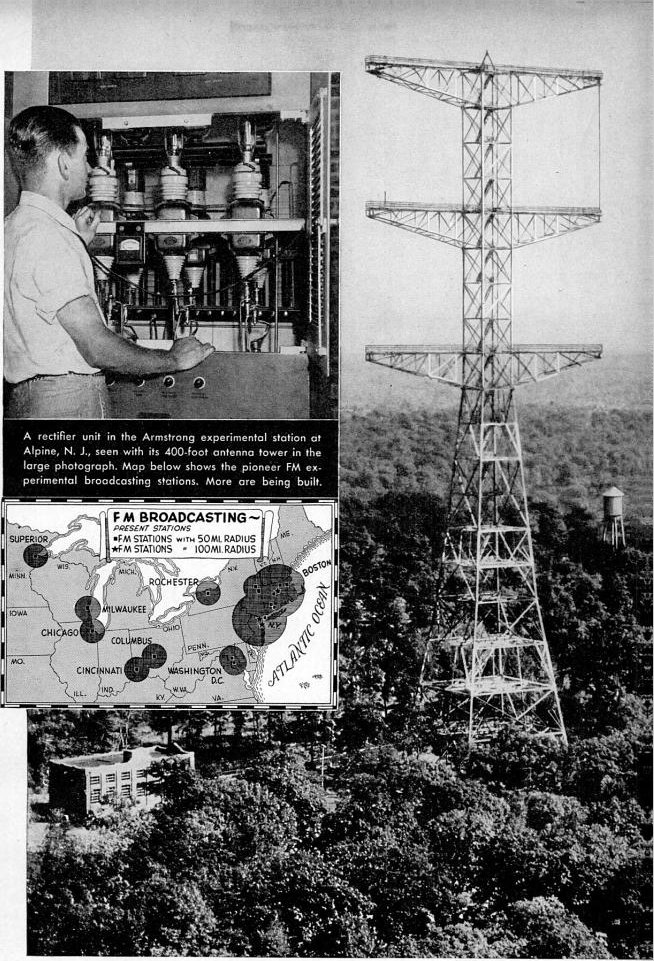History of radio § Broadcasting
History of radio § Broadcasting
Pre-emphasis and DE-emphasis
Random noise has a triangular spectral distribution
in an FM system, with the effect that noise occurs predominantly at the highest
audio frequencies within
the baseband. This can be
offset, to a limited extent, by boosting the high frequencies before transmission and reducing them by a corresponding amount
in the receiver. Reducing the high audio frequencies in the receiver also
reduces the high-frequency noise. These processes of boosting and then reducing
certain frequencies are known as pre-emphasis and de-emphasis, respectively.
The amount of pre-emphasis and de-emphasis used is
defined by the time
constant of a simple RC filter circuit. In
most of the world a 50 µs time
constant is used. In the Americas and South Korea, 75 µs is
used. This applies to both mono and stereo transmissions.
For stereo, pre-emphasis is applied to the left and right channels before multiplexing.
The use of pre-emphasis becomes a problem because of the
fact that many forms of contemporary music contain more high-frequency energy
than the musical styles which prevailed at the birth of FM broadcasting.
Pre-emphasizing these high frequency sounds would cause excessive deviation of
the FM carrier.
Modulation control (limiter) devices are used to prevent this. Systems more
modern than FM broadcasting tend to use either program-dependent variable
pre-emphasis; e.g., dbx in
the BTSC TV sound system or none at all.
Stereo FM
Long before FM stereo
transmission was considered, FM multiplexing of other types of audio level
information was experimented with.[4] Edwin
Armstrong who invented FM was the first to experiment with multiplexing, at his
experimental 41 MHz station W2XDG located on the 85th floor of the Empire State Building in New York City.
The first FM subcarrier
transmissions emanating from Major Armstrong's experimental station KE2XCC at
Alpine, New Jersey occurred in 1948. These transmissions consisted of
two-channel audio programs, binaural audio programs and a fax program. The
original sub-carrier frequency used at KE2XCC was 27.5 kHz. The IF
bandwidth was ±5 kHz, as the only goal at the time was to relay AM
radio-quality audio. This transmission system notably used a 75 µs audio
pre-emphasis, a technical innovation that became part of the original FM Stereo
Multiplex Standard.
The first FM subcarrier
transmissions emanating from Major Armstrong's experimental station KE2XCC at
Alpine, New Jersey occurred in 1948. These transmissions consisted of
two-channel audio programs, binaural audio programs and a fax program. The
original subcarrier frequency used at KE2XCC was 27.5 kHz. The IF
bandwidth was ±5 kHz, as the only goal at the time was to relay AM
radio-quality audio. This transmission system notably used a 75 µs audio
pre-emphasis, a technical innovation that became part of the original FM Stereo
Multiplex Standard.
In the late 1950s, several
systems to add stereo to FM radio
were considered by the FCC. Included were
systems from 14 proponents including Crosby, Halstead, Electrical and Musical
Industries, Ltd (EMI), Zenith, and
General Electric. The individual systems were evaluated for their strengths and
weaknesses during field tests in Uniontown, Pennsylvania using KDKA-FM in Pittsburgh as the originating station. The Crosby
system was rejected by the FCC because it was incompatible
with existing subsidiary communications authorization (SCA) services which used various subcarrier
frequencies including 41 and 67 kHz. Many revenue-starved FM stations used
SCAs for “storecasting” and other non-broadcast purposes. The Halstead system
was rejected due to lack of high frequency stereo separation and reduction in
the main channel signal-to-noise ratio. The GE and Zenith systems, so similar
that they were considered theoretically identical, were formally approved by
the FCC in April 1961 as the standard stereo FM broadcasting method in the
United States and later adopted by most other countries.[5][6] It is important that stereo broadcasts be compatible
with mono receivers. For this reason, the left (L) and right (R) channels are
algebraically encoded into sum (L+R) and difference (L−R) signals. A mono
receiver will use just the L+R signal so the listener will hear both channels
through the single loudspeaker. A stereo receiver will add the difference signal
to the sum signal to recover the left channel, and subtract the difference
signal from the sum to recover the right channel.




Comments
Post a Comment